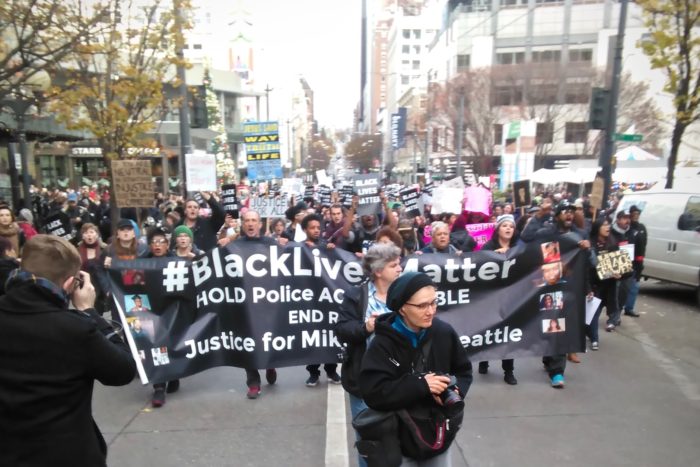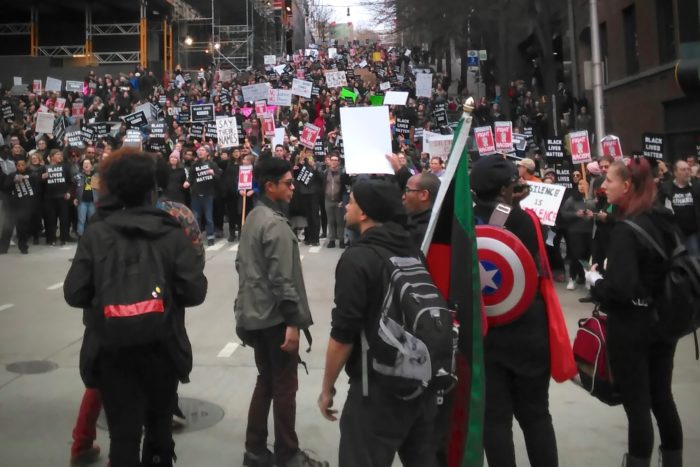
This story originally ran in the South Seattle Emerald.
Black Lives Matter activists and supporters marched through downtown Seattle and South Lake Union Friday to highlight systematic racism in the United States. The annual protest, which began at Westlake Square, drew an estimated crowd of 1,000 people.
Organized by Mohawk Kuzma, an organizer affiliated with the Seattle Black Liberation Front, the march was directed by activists from the Seattle Black Book Club, UW Black Student Union, and Anak Bayan, a Filipino-led radical community organization.
Now in its third year, the march centered Black voices — particularly women and transgender women. This year feelings of fear, frustration, and anger were palpable due to the outcome of the presidential election.
Though the march’s composition was a fairly diverse mix, the fact that people of color were outnumbered at the event was a point of frustration to the event’s organizers. “It’s really hard. There’s a lot of white people here,” said Evana Enuele, a prominent local activist who helped organize the event. This has been the trend at most Westlake-area protests over the past few years.
Several marchers of color mentioned fearing for their safety on a daily basis while living in America, including D’Sund Heller, a young activist who said, “I’m scared for my life every single day. On my 17th birthday, in New York City, I was stopped by police….if my mother wasn’t there, I didn’t know what would’ve happened.”
Others noted that President-elect Donald Trump, as a candidate frequently committed himself to mass deportations, ‘law-and-order’-style criminal justice policies, the expansion of the fossil fuel industry; and routinely insulted people of color, women, Muslims, immigrants, and LGBTQ people.
Though he called the protest, Kuzma declined to comment on Friday’s action, but co-organizer Courtney Thomas, stated the march had been far more energized than it had been in previous years.
She added that “people are ready to get into the streets now,” referring to the rise in popular anger provoked by the unexpected victory of Trump.
Other notable community groups participating in the march included Revolution Washington, along with members of the National Asian Pacific American Women’s Forum, and Socialist Alternative.
Roderick Thomas, a member of Our Revolution Washington gathered signatures for Initiative 873 during the protest. The initiative – which would make prosecution of law enforcement for homicide easier- was the main reason he attended.
“This is very important to me; especially as a Black Man. Trump’s election created a hostile environment […] and this isn’t the time to cower in fear or retreat to safe spaces. This is the time to fight harder than ever,” he said.

The protesters’ enthusiasm showed as they made their way up Pike Street toward Third Avenue as onlookers joined the crowd or signaled support.
The action did largely center voices who are most impacted and marginalized by public policy decisions. Aina Braxton, a protester who was leading one of the speaker-circles reflected the ethos of the entire march today:
“I came out here as a mom and a concerned citizen of this nation, I am a patriot, a fighter, a mother and the descendant of slaves and of the Blackfoot tribe. I’m concerned for what we’re doing and why we’re not focusing on Climate Change and why we’re not trying to love each other, why we’re not trying to feed each other,” Braxton said.
She went on to suggest that her neighbors, educators and public at large need to engage with the new reality of Donald Trump and blatant white supremacy, “People still want to have this pollyanna and whitewashed idea of what the world is like. What Donald Trump espouses and that’s dangerous […] here in Seattle, I see educators trying to talk about this but, get blocked left and right.”
On Friday, protesters joined in the frustration of being hindered as they unsuccessfully attempted to march on City Hall. They were met by a full cordon of Seattle police officers.
Braxton saw the blocking as an affront to civic protests.
“I’ve seen actions before and with hundreds of people marching, it could actually be dangerous and this Mayor should listen to his people,” she said.
When asked to elaborate more on what she meant, she said she called on Mayor Ed Murray to instill within the police force that SPD should embrace protest marches like Friday’s in order to foster more civic engagement.
Towards the end of the march, and after an attempted direct action at Zara, a clothing store in Westlake Center, the protests reconvened at Fifth Avenue and Pike Street. Speakers alternated on the microphone, and true to the intent of the march, the voices were of Black women, women of color and Black and brown trans-women.
One speaker, Eridon Stewart, a Washington Middle School student who has organized student protests in response to the election, fired up the crowd with an emphatic speech:“Everything I said has come deep down inside of me, because everybody knows and even the racist people know what they’re doing is wrong” Eridon went on to express why she came out here, “power, you can’t put it in the wrong people’s hands or else they’ll use it in the wrong way and hurt everybody.”
Nikkita Oliver, a lawyer, poet and community activist also spoke and urged white allies and supporters to treat this issue with a heightened urgency and begin to take risks and their own personal privileges in response to an escalating environment of white supremacy. Oliver also specified concrete actions that allies in the community can take to fight for Black lives:
“Solidarity looks like white folks making sacrifices that Black folks have been making for a long time….most important, show up in your workplace, wherever you are. Think about how you spend your money and where you spend your money. There are a number of ways but, it all comes down to sacrifice. Are you willing to sacrifice money, your job, family relationships, personal relationships, perhaps not screwing or passing up an opportunity? White folks get more than their fair share and white folks need to be more cognizant of their access to resources in this society.”
The march then recommenced on the downtown streets but failed to access Capitol Hill due to a police blockade. It did spill out onto Mercer Street in South Lake Union, with many marchers thinking this fitting given Amazon’s controversial history with displacement in the area, and the predominantly white tech industry it’s a part of.
Concluding peacefully without any arrest, the protest was one of the largest Black Friday demonstrations Seattle’s held in recent years. Friday’s protest seemed to mean more than the previous, ritualistic demonstrations.
Earlier in the day, an organizer of the International Brotherhood of Electrical Workers Union provided a summation of the day shared by many demonstrators: “today was great, coming to this protest is great, but we don’t need more protesters, we need more organizers.”


Great piece but needs more Social Justice warrior buzzwords and cliches. Start with “intersectional”, and don’t forget “cis”.